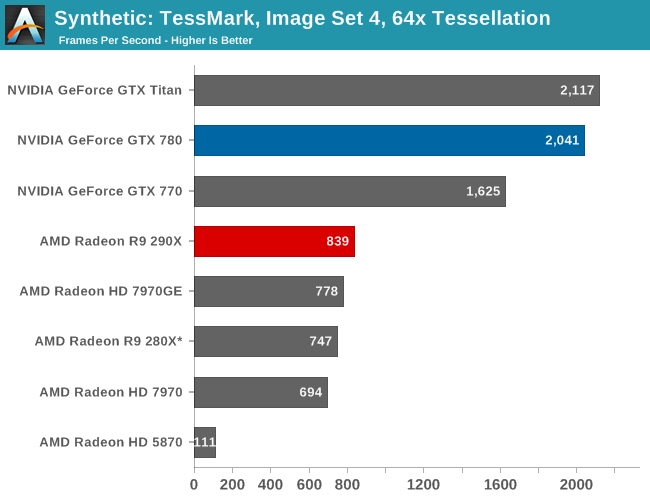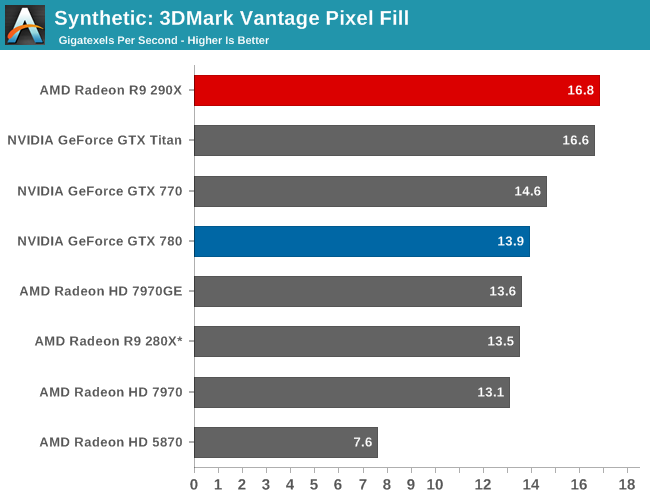The AMD Radeon R9 290X Review
by Ryan Smith on October 24, 2013 12:01 AM EST- Posted in
- GPUs
- AMD
- Radeon
- Hawaii
- Radeon 200
Synthetics
As always we’ll also take a quick look at synthetic performance. The 290X shouldn’t pack any great surprises here since it’s still GCN, and as such bound to the same general rules for efficiency, but we do have the additional geometry processors and additional ROPs to occupy our attention.

Right off the bat then, the TessMark results are something of a head scratcher. Whereas NVIDIA’s performance here has consistently scaled well with the number of SMXes, AMD’s seeing minimal scaling from those additional geometry processors on Hawaii/290X. Clearly Tessmark is striking another bottleneck on 290X beyond simple geometry throughput, though it’s not absolutely clear what that bottleneck is.
This is a tessellation-heavy benchmark as opposed to a simple massive geometry bencehmark, so we may be seeing a tessellation bottleneck rather than a geometry bottleneck, as tessellation requires its own set of heavy lifting to generate the necessary control points. The 12% performance gain is much closer to the 11% memory bandwidth gain than anything else, so it may be that the 280X and 290X are having to go off-chip to store tessellation data (we are after all using a rather extreme factor), in which case it’s a memory bandwidth bottleneck. Real world geometry performance will undoubtedly be better than this – thankfully for AMD this is the pathological tessellation case – but it does serve of a reminder of how much more tessellation performance NVIDIA is able to wring out of Kepler. Though the nearly 8x increase in tessellation performance since 5870 shows that AMD has at least gone a long way in 4 years, and considering the performance in our tessellation enabled games AMD doesn’t seem to be hurting for tessellation performance in the real world right now.
Moving on, we have our 3DMark Vantage texture and pixel fillrate tests, which present our cards with massive amounts of texturing and color blending work. These aren’t results we suggest comparing across different vendors, but they’re good for tracking improvements and changes within a single product family.

Looking first at texturing performance, we can see that texturing performance is essentially scaling 1:1 with what the theoretical numbers say it should. 36% better texturing performance over 280X is exactly in line with the increased number of texture units versus 280X, at the very least proving that 290X isn’t having any trouble feeding the increased number of texture units in this scenario.

Meanwhile for our pixel fill rates the results are a bit more in the middle, reflecting the fact that this test is a mix of ROP bottlenecking and memory bandwidth bottlenecking. Remember, AMD doubled the ROPs versus 280X, but only gave it 11% more memory bandwidth. As a result the ROPs’ ability to perform is going to depend in part on how well color compression works and what can be recycled in the L2 cache, as anything else means a trip to the VRAM and running into those lesser memory bandwidth gains. Though the 290X does get something of a secondary benefit here, which is that unlike the 280X it doesn’t have to go through a memory crossbar and any inefficiencies/overhead it may add, since the number of ROPs and memory controllers is perfectly aligned on Hawaii.










396 Comments
View All Comments
Ytterbium - Monday, October 28, 2013 - link
It's kind of funny that for computer your better off buying the lower down 280X cards, I guess that AMD saw what NVidia did with the Titan and though we'll have some of that, they'll be a pronsumer card with 1/4 FP for $1000SolMiester - Monday, October 28, 2013 - link
You obviously dont know 780Ti is coming! hell, even OC 780 is better than current Titan which is PROsumer for CUDA dev...that why it has different model naming..Anyway, if you can keep the 290x under 94c without throttling, it is indeed a great card, however the review I have seen with sustained gaming have it throttling up to -30%
motqalden - Sunday, October 27, 2013 - link
Lol R9 290X CF "Uber" 66.6 dB(A)Go Red Team ^.^
>.> 666 + Red team
Remember. Competition is a good thing!
Ryan Smith - Monday, October 28, 2013 - link
And I ran that test 3 times to make sure it wasn't a fluke. It really is 66.6dB(A).faster - Sunday, October 27, 2013 - link
SOFT LAUNCH Too bad the cards aren't available anywhere from 10/24/2013 to 10/27/2013 besides a handful on the first day that went to the lucky 100.AnnihilatorX - Monday, October 28, 2013 - link
Minor typo:The closest we came to a problem was with the intro videos for Total War: Rome 2, which have black horizontal lines due to the cards trying to the cards trying to AFR render said video at a higher framerate than it played at.
Ryan Smith - Monday, October 28, 2013 - link
Thanks.AnnihilatorX - Monday, October 28, 2013 - link
I do hope 3rd party has more support watercooling, there is a gap in market for affordable prebuilt CPU with water blocks.muziqaz - Sunday, November 3, 2013 - link
On release date in ocUK website there were i think 2 cards with prebuilt watercooling block for available. So I guess watercooling is being supported ;)AnnihilatorX - Monday, October 28, 2013 - link
oops, CPU-->GPU